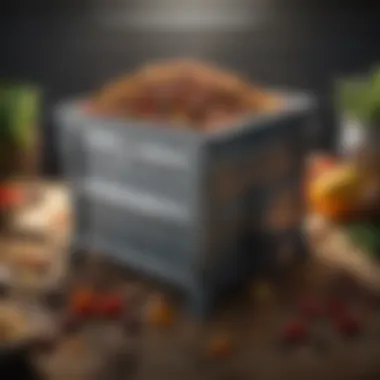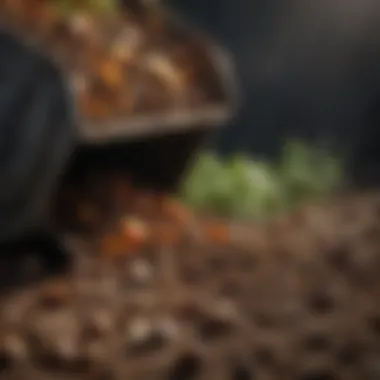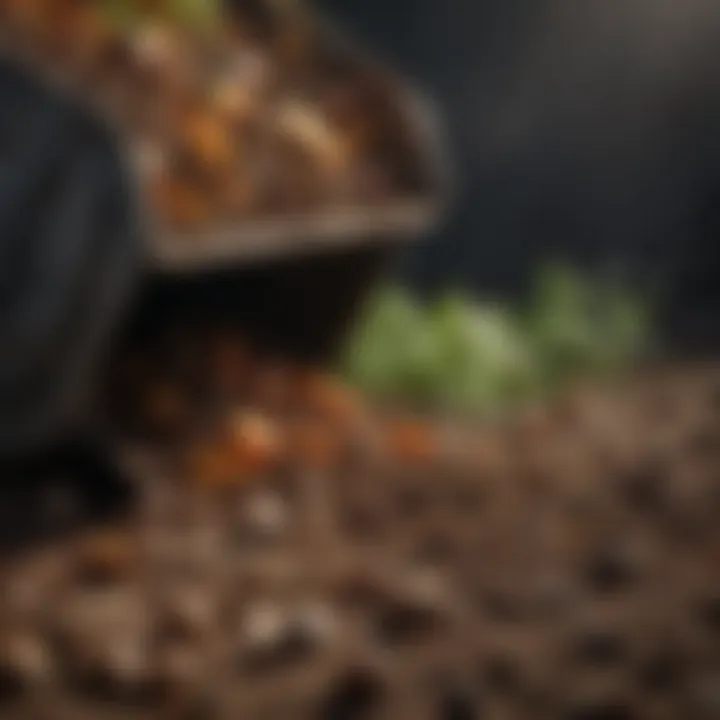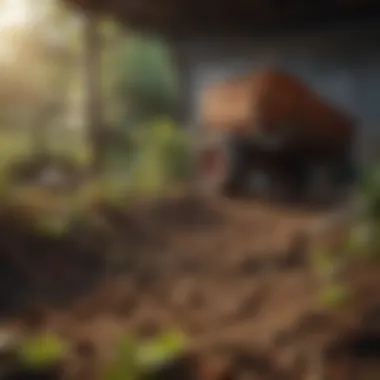Understanding Food Composters: A Comprehensive Guide


Overview of the Topic
Definition and Importance
Food composters play a vital role in modern sustainable practices, transforming kitchen scraps and organic waste into nutrient-rich soil. Essentially, a food composter is designed to facilitate the natural decomposition of organic materials. This process not only reduces the volume of waste that ends up in landfills but also enriches the soil, promoting healthier plant growth. In a world facing the pressing issues of climate change and soil degradation, understanding the ins and outs of food composters becomes increasingly crucial.
Composting organic matter helps decrease greenhouse gas emissions. When food waste decays in landfills, it produces methane, a potent greenhouse gas. In contrast, composting these materials aerates them, allowing for efficient breakdown and preventing harmful emissions. This makes composting a win-win not only for the environment but also for anyone interested in enhancing agricultural productivity.
Current Trends
The surge in eco-awareness has led many to embrace composting in a variety of forms. Several trends have emerged in this niche. For instance, indoor composting is gaining popularity among urban dwellers who may not have access to outdoor spaces. Compact vermicomposters, which use worms to decompose organic waste, are particularly appealing due to their minimal footprint and fast processing time. Moreover, many communities are establishing local composting hubs, turning waste management from an isolated task into a community effort.
Key Techniques and Practices
Step-by-Step Guide
Composting may seem daunting at first, but a straightforward approach can demystify the process. Here’s a quick guide to help anyone kick off their composting venture:
- Choose Your Composter: Decide between an outdoor bin, worm composter, or a kitchen compost pail.
- Gather Materials: Start collecting kitchen scraps like vegetable peels, coffee grounds, and eggshells. Include browns, such as dried leaves and cardboard.
- Layering: Alternate layers between greens (nitrogen-rich materials) and browns (carbon-rich materials) for optimal decomposition.
- Aerate: Turn the compost regularly to introduce oxygen. This encourages aerobic decomposition, preventing odors.
- Moisture Control: A balanced moisture level is crucial. If too wet, add dry browns; if too dry, sprinkle some water.
- Patience: Depending on conditions, compost can take several weeks to months to mature. When it's dark and crumbly, it's ready to use.
Tools and Equipment Needed
While composting can be done with minimal equipment, certain tools can make the process smoother:
- Compost Bin: Many options are available, from tumblers to bins that aerate on their own.
- Pitchfork or Shovel: Essential for aerating and turning the compost.
- Garden Gloves: Keeping hands clean is a must, especially when dealing with decomposing matter.
- Compost Thermometer: For those serious about optimal temperatures during composting.
- Kitchen Scraps Container: A simple container designed for storing waste until it goes to the compost bin.
Challenges and Solutions
Common Obstacles
Despite its benefits, composting can pose several challenges:
- Pests: Improperly managed compost can attract rodents and other pests.
- Odors: A poorly balanced compost pile may emit unpleasant smells.
- Time: Many people feel they lack the time to manage compost effectively.
Innovative Solutions
Addressing these challenges requires creative thinking. Here are some solutions to common composting problems:
- Pest Control: Using a sealed compost bin can deter pests and minimize odors. Additionally, keeping the compost pile aerated reduces the risk of creating an attractive habitat for rodents.
- Balanced Ingredients: Regularly check the ratio of greens to browns. When balanced correctly, compost will produce minimal odor.
- Set a Schedule: Designate specific days of the week for compost maintenance to streamline the process. This makes composting feel less like a chore and more like a routine.
“To create a sustainable environment, one must first cultivate healthy soil.”
Adopting composting practices represents an essential step toward responsible waste management and promoting agricultural sustainability.
Foreword to Food Composting
In a world where food waste is a significant concern, understanding food composting becomes paramount. This method not only addresses the mounting piles of kitchen scraps but provides a means to enrich the soil and combat climate change. Composting is, in essence, nature's way of recycling biodegradable waste, turning what many view as trash into a valuable resource that can enhance various agricultural practices.
Definition of Composting
Composting is the process of decomposing organic waste materials through the action of microorganisms, earthworms, and other decomposers. While this sounds simple enough, there's a bit more to it than meets the eye. The decomposition occurs in a controlled environment, which allows the organic materials—like fruit peels, vegetable scraps, and even eggshells—to break down into a dark, nutrient-rich substance known as compost. This compost can then be used to improve the quality of soil in gardens and farms alike. In essence, when you compost, you mimic nature's decay process but with the goal of producing something beneficial for the earth.
Importance of Composting in Agriculture
Composting holds crucial significance in agriculture for several reasons. First and foremost, it provides a sustainable solution to manage organic waste, reducing the need for chemical fertilizers, which can have detrimental effects on the environment. Additionally, compost enriches the soil with essential nutrients, enhances moisture retention, and promotes healthy microbial activity. This means that crops grown in compost-amended soils tend to have better yields and are more resilient to diseases and pests.
Moreover, when farmers incorporate compost into their practices, they contribute to a reduction in greenhouse gas emissions. Food waste, when sent to landfills, generates methane, a potent greenhouse gas. By composting, they help keep these materials out of landfills and in their rightful place—returning organic matter back to the soil.
"The act of composting transforms waste into a treasure that rejuvenates the land and sustains future generations."
It's also worth noting that as society evolves, the call for sustainable farming practices grows louder. This is where composting can truly shine. Beyond individual farms, when practiced on a large scale, composting can lead to healthier ecosystems, improving soil structure and biodiversity. In the long run, understanding and implementing composting in agriculture not only supports farmers’ bottom lines but also endorses a healthier planet for all.
How Food Composters Work
Understanding the inner workings of food composters is pivotal for anyone who desires to take their culinary scraps and organic waste and transform them into nutrient-rich compost. This section explores the intricacies of how food composters function, the science at play, and the key elements that make composting effective. Knowing these components not only enhances your composting experience but also maximizes the benefits you reap from your garden or farm.
The Science Behind Composting
Composting is fundamentally a natural process that mimics decomposition. It involves a community of microorganisms, bacteria, and fungi that work tirelessly to break down organic matter. When you provide the right conditions, these friendly critters go to town, munching on your food scraps and turning them into a rich soil-like substance.
The whole shebang hinges on the biological reactions that occur when you layer different components, like greens (wet materials) and browns (dry materials). The heat produced through microbial metabolism accelerates the breakdown of organic materials. Many people don't realize that the by-product of this activity is not just any compost, but a veritable gold mine for soil enhancement.
Key Components of Composting
Effective composting is contingent on a few critical ingredients. If you nail these, you’re well on your way to producing quality compost that enriches your soil and reduces waste effectively. Let’s dive into these components:
Carbon-Rich Materials
Carbon-rich materials, often referred to as "browns," are a must-have in the composting equation. They include things like dried leaves, straw, and cardboard. Their key characteristic is a high carbon content, which is essential for the maintenance of microbial growth and energy balance.


These materials provide structure to the compost pile, preventing it from becoming compacted. When properly balanced with nitrogen-rich components, they become the backbone of a thriving composting ecosystem. An advantage of carbon-rich materials is their accessibility; many gardeners already have them lying around, waiting to be repurposed. However, on the flip side, too much brown material without sufficient nitrogen can greatly slow down the composting process.
Nitrogen-Rich Materials
Nitrogen-rich materials, or "greens," are equally crucial for effective composting. This category includes items like fruit and vegetable scraps, coffee grounds, and grass clippings. The standout characteristic of these materials is their role in fuel—providing the necessary nitrogen that microbes feast on.
This high nitrogen content gives compost its vital nutrient profile. Furthermore, greens speed up the decomposition process compared to browns, contributing to heat generation within the compost pile. However, too much nitrogen can lead to a smelly pile and unwanted pests. Striking a balance between greens and browns is key here.
Moisture and Aeration
Moisture and aeration might seem like back-end nuances, but they are crucial players in the composting game. Keeping the right moisture level—similar to that of a wrung-out sponge—ensures that microorganisms thrive. Too much moisture can lead to anaerobic conditions, fostering unwanted odors and slow decomposition.
Aeration, or making sure your pile has enough air flow, is what keeps the composting process from going stagnant. Turning the pile or using a tumbler composter ensures that oxygen reaches the microorganisms, which is vital for their activity and overall compost health. By maintaining the right moisture and aeration levels, you ensure the composting process is efficient and effective.
"Well-balanced compost piles with proper moisture and aeration accelerate the transformation of food waste into valuable nutrient-rich compost."
With these fundamental components in place, you can embark on your composting journey equipped with the knowledge necessary for success. By understanding how food composters work, you'll be well-prepared to produce a high-quality compost that supports sustainable practices and enhances soil fertility.
Types of Food Composters
In the realm of composting, understanding the various types of food composters can pave the way for more efficient practices tailored to individual needs and circumstances. Each composter offers distinct features that appeal to different lifestyles, preferences, and environmental conditions. Here’s an in-depth look at the main categories of food composters available today, focusing on their unique benefits and considerations, particularly for those engaged in agriculture, whether professional or hobbyist.
Vermicomposting
Vermicomposting, often seen as the gold standard among composters, utilizes worms to break down organic matter. Specifically, red wiggler worms are favored for their voracious appetite for food scraps. This method not only generates rich compost but also produces worm tea—a nutrient-dense liquid fertilizer that is excellent for fertilizing crops.
Using a vermicomposter is a bit like having your cake and eating it too. You gain both compost and a nifty way to recycle food scraps without needing vast space. It’s quite efficient for small gardens or even apartment dwellers.
“Worms can consume about half their body weight in food scraps daily. That’s a whole lot of potential compost!”
Consider these points when opting for vermicomposting:
- Space requirements: A small bin can suffice.
- Temperature factors: These worms are sensitive to extreme heat and cold.
- Maintenance: Regular feeding and monitoring are necessary.
Electric Composters
Electric composters bring a futuristic twist to the traditional composting approach. These machines use heat, agitation, and sometimes even moisture to rapidly decompose food waste into compost within a matter of hours or days. For busy urban dwellers, this method can be incredibly appealing due to its speed and convenience.
Advantages include:
- Indoor use: Can be placed in your kitchen or utility room.
- Fast processing time: More immediate results for impatient gardeners.
- Odor control: Most models are designed to minimize unpleasant smells.
However, they do come with their drawbacks. They generally require electricity and maintain a consistent temperature, which could be a consideration in areas with unstable power supplies.
Batch Composters
Batch composters are all about efficiency. You load materials into the composter at once, and once it’s full, the process begins. A key highlight of this type is that it allows you to keep composting during the breakdown time, saving both time and energy.
These composters often feature a sealed design, which is helpful in managing odors while also preventing pests from getting in.
Things to keep in mind:
- Requires sufficient space for multiple batches.
- You need to keep track of when to add new material.
- Completion time for each batch can vary.
Continuous Composters
Continuous composters are designed for ongoing use. These units allow you to add scraps continuously, meaning they work like a conveyor belt of composting. The beauty of continuous composters lies in their seamless operation, where decomposed material at the bottom can be harvested, while new waste is added at the top.
Pros of continuous systems:
- Ongoing compost production—great for sustaining a garden over the season.
- Less need for detailed tracking than with batch systems.
- Generally, easy access for daily contributions.
On the flip side, they may not break down scraps as quickly as electric or batch composters.
Tumbler Composters
Tumbler composters are like exercise equipment for your organic waste. They are cylindrical bins mounted on a frame that lets you turn or rotate them. This movement ensures that air circulates throughout the compost, speeding up the decomposition process.
When opting for a tumbler, consider:
- Turning Easily: Mixing materials is straightforward, which helps speed decomposition.
- Cross-Contamination Risks: Watch out for the materials you add to avoid introducing unsuitable components.
- Capacity: If you have a larger space, bigger tumblers hold more compost mixture.
The importance of selecting the right type of composter cannot be overstated. Each has its characteristics that bone out best practices depending on specific circumstances. Understanding the nuances can enhance the composting outcomes, influencing environmental implications and agricultural productivity.
Benefits of Using Food Composters
The use of food composters presents a tapestry of advantages that stretch beyond mere convenience. They play a pivotal role in transforming our kitchen scraps into rich, nourishing soil. In this section, we delve into the multifaceted benefits that utilizing food composters affords us, emphasizing their significance in not just the home garden but also in the expansive realm of agriculture.
Reducing Food Waste


Food waste has become a substantial issue in our modern society. It’s astonishing, really; a large portion of edible food ends up in landfills instead of being put to good use. Food composters can help turn this tide. By composting food scraps, we close the loop on waste. Instead of letting fruits, vegetables, and even some grains rot away, we transform them into valuable compost, decreasing the amount of waste sent to landfills.
In practical terms, this means that if a family with four members composts their food waste, they could save several hundred pounds of waste from going to the landfill annually. That's no small potato. Reducing food waste not only helps manage waste but also conserves valuable resources that went into producing that food, such as water and energy.
Enhancing Soil Fertility
Composting is like giving back to the earth. When food composters break down organic matter, they create a rich blend of beneficial nutrients that can significantly enhance soil fertility. Compost can improve soil structure, allowing it to retain moisture and nutrients more effectively.
Farmers and gardeners alike can witness the benefits firsthand. A handful of compost can work wonders in sandy or compacted soils, transforming barren patches into thriving ecosystems. Nutrients released into the soil from compost contribute to healthy plant growth, reducing the need for synthetic fertilizers, which can sometimes do more harm than good.
- Adding compost to soil:
- Boosts microbial activity
- Increases organic matter in the soil
- Enhances crop yield and quality
Thus, food composters don't merely dispose of waste but actively enrich the very ground upon which we depend.
Supporting Sustainable Practices
Integrating food composting into our daily lives resonates with broader sustainability efforts. By opting for food composters, individuals contribute to a more sustainable lifestyle. This is especially vital considering the growing concern about climate change and environmental degradation.
Using compost reduces the carbon footprint of waste management. Composters need minimal energy to function, allowing for a more energy-efficient means of handling organic waste. This simplistic approach minimizes greenhouse gases, particularly methane, which is emitted when organic material decomposes anaerobically in landfills.
"Food composters not only reduce waste but also enable sustainable practices that can have lasting effects on our environment."
Furthermore, composting supports biodiversity. Compost enriches soil that can sustain a wider variety of plants, which, in turn, supports diverse ecosystems. This connection is crucial in preserving local flora and fauna, especially in urban settings where green spaces are limited.
Selecting the Right Food Composter
Choosing the right food composter can create a world of difference in your composting journey. It’s not just about throwing scraps into a bin; it’s about understanding how your choice affects the quality of compost you produce, how convenient it is to use, and how well it fits into your lifestyle. Understanding this decision can lead to greater composting success and, ultimately, healthier soil.
Assessing Your Space
Before diving into the world of composters, take a good, long look at the space you have available. Do you live in a tiny apartment with no yard to speak of? Or perhaps you have a sprawling backyard that could accommodate a large bin? Figuring out your available square footage is crucial because, let’s face it, the last thing you want is a composter that takes up more room than you have.
- Here are a few things to consider while assessing your space:
- Size of the Composter: If you're working with a small patio or balcony, then a compact or countertop option like a Bokashi bin might be best. In contrast, if you have a lot of outdoor space, larger tumbler or continuous composters could suit your needs well.
- Accessiblity: Your chosen composter should be easy to access for adding scraps and turning material. A difficult-to-reach composter will likely lead to neglect and those valuable scraps turning stale.
- Location: Place the composter in a spot that gets adequate sunlight and isn’t too close to your living spaces. Odors can sometimes arise, and better ventilation is key to an effective composting process.
Understanding Your Needs
Next, reflect on what you actually need from a composter. Are you someone who cooks a lot and generates a fair amount of food scraps, or do you merely discard the occasional banana peel?
Make a checklist:
- Volume of Food Waste: Larger households or farms may require high-capacity composters that can handle a hefty amount of food waste at once.
- Types of Materials: Different composters handle different materials. If you want to compost everything from fruit peels to meat scraps, you should consider electric composters that can handle a wide variety.
- Your Commitment Level: Some composters need more frequent attention – think aerating and turning – while others are more hands-off. Assess how much time and effort you can realistically devote to this endeavor.
Budget Considerations
Finally, your budget will play a significant role in which composter you opt for. It's easy to get carried away when you discover all the options available, but it’s vital to establish some ground rules.
- Price Ranges: Composters can range from basic DIY setups that cost little to nothing, to advanced electric ones that can be a significant investment. Know how much you’re willing to spend before you start shopping.
- Long-Term Value: Consider the long-term savings from using a more efficient model that produces high-quality compost more quickly. Investing a bit more upfront may yield better results and efficiency in the long run.
- Maintenance Costs: Don’t forget about potential maintenance costs. Some systems might require extra materials or tools, adding to your expenses.
In summary, finding the right com poster combines understanding your available space, assessing what you need from it, and planning your budget. This careful selection process will help you maximize your composting efforts and ultimately contribute to a more sustainable lifestyle.
Navigating through this can feel overwhelming, but taking these steps will equip you with the clarity you need to make a well-informed decision.
Best Practices for Composting Food Waste
Composting food waste is not just a beneficial activity; it's a way to contribute positively to the environment and to our health. To get the most out of your composting efforts, following best practices is crucial. These practices ensure not only the efficiency of decomposition but also the quality of the compost produced.
Maintaining Ideal Conditions
Maintaining ideal conditions in your compost bin is essential for speedy decomposition and healthy microbial activity. Two key aspects of this are temperature control and aeration techniques.
Temperature Control
Temperature control is fundamental in the composting process. When composting, the microbial activity generates heat, and maintaining the right temperature fosters this process. Typically, a temperature range of 130°F to 160°F encourages efficient decomposition. At these temperatures, beneficial microorganisms thrive while pathogens and weed seeds are destroyed.
One of the key characteristics of temperature control is its ability to indicate the health of your compost pile. If your pile feels too hot, you might need to aerate it to bring in oxygen. Conversely, if it’s too cold, adding more nitrogen-rich materials can help heat things up again.
The unique feature of temperature control is its direct correlation with the composting timeline. Higher temperatures can significantly reduce the time it takes for organic material to decompose, which is a major plus for those looking to produce compost quickly. However, it can also lead to some challenges. For example, if temperatures consistently rise above 160°F, certain beneficial microorganisms may die off, slowing down the decomposition instead of speeding it up.
Aeration Techniques
Aeration techniques are crucial for maintaining a balanced compost environment. Aeration involves introducing air into the compost pile, which is vital for aerobic bacteria that thrive in oxygen-rich settings. Without proper aeration, the composting process can turn anaerobic, producing unpleasant odors and harmful byproducts.
A key characteristic of effective aeration techniques is that they can be straightforward and accessible. Turning the pile with a pitchfork or adding materials like straw and leaves can enhance airflow, ensuring that all compost components are adequately exposed to oxygen.
The unique aspect of incorporating aeration techniques is that they can be tailored depending on your specific composting method. For instance, a tumbler composter inherently facilitates aeration due to its design, while static piles may require more manual intervention. The advantage of well-aerated compost is that it dramatically speeds up the breakdown of materials, yielding rich compost in a shorter timeframe. A disadvantage, however, is that it might require a bit more effort from the composter, especially if you're working with large quantities of waste.


Troubleshooting Common Issues
Despite following best practices, composters may still encounter problems. Some common issues include odors, pests, and slow decomposition. Understanding these problems and knowing how to address them is part of successful composting.
For unpleasant odors, often associated with anaerobic conditions, increasing aeration can resolve the issue. If pests become a problem, it's usually a sign of excess food waste; reducing the amount of scraps added may help. Lastly, slow decomposition is often tied to an imbalance in materials. Regularly checking the carbon to nitrogen ratio can facilitate speedy breakdown, allowing your compost to thrive.
"Good composting is all about balance—too much of one thing can tip the scale and cause issues. Pay attention to the signs!"
Epilogue
Following these best practices strengthens your composting journey. From temperature control to effective aeration, understanding these elements enhances the decomposition process. Troubleshooting will further refine your technique, making sure that every scrap of food waste contributes to something greater. In the end, a little diligence leads to rich, fertile compost that nourishes your plants and benefits the environment.
Environmental Impact of Food Composters
Understanding the environmental impact of food composters is crucial in our quest for sustainable practices. Food waste contributes significantly to landfill overflow, producing harmful greenhouse gases. Composting not only helps mitigate these issues, it also plays a vital role in enhancing soil health and promoting biodiversity. The focus here is on how food composters can transform our organic waste into valuable resources, providing a double-edged sword against pollution and nutrient depletion in our lands.
Carbon Footprint Reduction
One of the most significant benefits of food composters is their role in reducing our carbon footprint. When food scraps end up in landfills, they decompose anaerobically, which means they break down without enough oxygen. This process results in the production of methane, a greenhouse gas that is vastly more potent than carbon dioxide. By diverting organic waste through composting systems, we prevent methane emissions.
Moreover, using compost enriches soil, improving its structure and moisture retention. This not only supports plant growth but also encourages carbon sequestration in the soil. When carbon is stored in soil organic matter, it effectively reduces the amount of CO2 in the atmosphere. This cycle—reducing waste at the source and enhancing the earth's capacity to store carbon—shows how composters directly address climate change concerns while promoting healthier ecosystems.
- Here are some actions composters reduce carbon emissions:
- Diverting organic waste from landfills protects against methane production.
- Encouraging healthy soil, which can sequester carbon.
- Establish forest-like conditions in agricultural settings, planting cover crops and practicing intercropping, which capture more CO2.
It's evident that food composters play a significant role in tackling climate-related issues by creating a more sustainable environmental approach.
Enhancing Biodiversity
The influence of food composters extends beyond just reducing waste. They also promote biodiversity, a critical element for sustainable ecosystem health. When compost is made from a variety of organic materials, it becomes a rich habitat for a myriad of beneficial organisms. These organisms, from earthworms to micro-organisms, enhance soil fertility and structure, allowing for better root growth and increased nutrient availability.
In urban settings, where biodiversity often takes a hit, composting offers a small-scale but impactful solution. Through composting, local communities can foster diverse gardens that not only provide food but also support various species. Examples include:
- Composting food scraps provides nutrients that nurture local flora.
- It attracts beneficial insects like pollinators and natural pest controllers, enriching urban green spaces.
- By implementing compost in public green spaces, cities can aid in the restoration of habitats that invite wildlife back.
"Composting fosters life, weaving a web of interconnected species that thrive together in harmony."
In summary, food composters serve as a powerful tool for environmental stewardship, enriching soil and boosting local biodiversity. As we embrace composting, we pave the way toward not only cleaner landfills but also healthier ecosystems.
Food Composting in Urban Settings
Urban environments present a unique landscape for food composting, where the usual challenges and benefits intertwine amid the hustle and bustle of city life. Composting in cities isn't just about reducing waste; it touches on broader themes like sustainability, community engagement, and oftentimes, economic growth. The importance of food composting in urban settings cannot be overstated. When cities manage their food waste properly, they mitigate environmental issues while enhancing local ecosystems.
Challenges Faced by Urban Composters
City dwellers looking to compost may find themselves wrestling with several challenges that can stunt their efforts:
- Space Constraints: Many urban residences, especially apartments, have little to no outdoor space for traditional composting methods. Balconies might not be easily suitable for large composters, causing residents to feel discouraged.
- Odor and Pests: In densely populated areas, the risk of attracting pests or creating odors that disturb neighbors could raise concerns for many would-be composters. Complaints can pop up quickly, leading to a halted composting endeavor.
- Regulatory Hurdles: Zoning laws and local ordinances might bring restrictions on composting activity. It's crucial that urban composters understand their local regulations to avoid any conflicts.
Urban composting can be a game changer, but to flourish, it requires navigating the complexities unique to city life, striking a balance between practicality and community considerations.
Innovative Solutions for City Dwellers
Despite the challenges, numerous innovative solutions have popped up to help urban composters thrive:
- Compact Composters: Manufacturers now produce smaller, more efficient composters, like countertop systems and bokashi bins, which allow composting to happen in tight spaces. These are designed for odor management and pest control, making them an appealing option for apartment dwellers.
- Community Composting Programs: Many cities have started community composting initiatives. These programs encourage residents to drop off their organic materials at neighborhood hubs, which are then processed collectively. This not only reduces individual stress about composting but fosters a sense of community engagement.
- Worm Bins: Vermicomposting has become an increasingly popular choice among city residents. Worm bins can fit under sinks or in closets, providing a compact and productive way to convert food scraps into rich compost without the same space demands as traditional methods.
By recognizing the challenges and actively seeking innovative solutions, urban composters can contribute significantly to sustainability efforts while finding practical ways to manage food waste effectively. This proactive approach promotes a culture of environmental responsibility while enhancing the quality of urban life.
Future of Food Composters
The future of food composters is not just a continuation of current trends; it's a dynamic shift towards sustainability and resourcefulness that aligns with farming practices. The pursuit of eco-friendly solutions has never been more urgent, making this topic pivotal for farmers and agricultural enthusiasts. As urbanization speeds up and the ecological footprint expands, finding effective ways to repurpose organic waste becomes vital. Understanding where food composters are heading can empower individuals and communities to make informed decisions that contribute positively to the environment.
Technological Advancements
The innovation in composting technology is revolutionizing how we process organic waste. Composters nowadays are designed with smarter features that simplify the composting process and make it more efficient. For example, some new models integrate sensors that measure temperature and moisture levels, sending alerts to users' smartphones to maintain optimal conditions. These advancements not only enhance compost quality but also make the process more accessible, especially for those in busy urban settings.
Here are some notable advancements to look out for:
- Automated Composters: These machines can process food waste autonomously, reducing the need for manual labor.
- Online Platforms for Monitoring: Users can connect with apps that provide tips and track composting progress.
- Compact DIY Solutions: Innovations in small-scale composters allow city dwellers to compost in tight spaces, like balconies or kitchens.
The ongoing development in composting technology hints at a future where composting is integrated into urban infrastructure, with composters becoming as commonplace as recycling bins.
Integration with Agricultural Practices
As food composters evolve, their integration with agricultural practices is becoming a standout feature. By using compost produced from organic waste, farmers can enhance soil health, improve crop yields, and reduce dependency on chemical fertilizers. Compost not only enriches soil but also helps retain moisture, making it a boon during dry spells.
Additionally, organic matter from compost can support microbial activity in the soil, creating a thriving ecosystem that fosters plant growth. This symbiotic relationship between composting and farming enhances sustainability which is increasingly important in today’s changing climate.
Agriculture is embracing composting in various ways, such as:
- Food Waste-to-Farm Initiatives: Programs that connect restaurants and farms, repurposing waste as compost.
- Community Supported Agriculture: Local farms using community compost to enrich their fields and promote local stewardship.
- Conservation Tillling: Employing compost with no-till practices preserves soil structure and biodiversity.
The acceptance of food composters in agricultural frameworks fosters a culture of sustainability and encourages other farmers to adopt composting, setting a ripple effect that can potentially transform rural landscapes.



